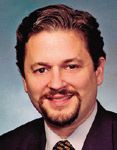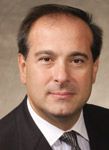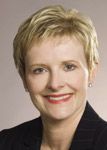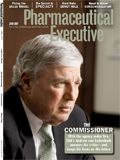Fixing the Sales Model
Pharmaceutical Executive
It was like the end of the arms race last November when Pfizer announced it was slashing its national sales force by 20 percent. Coolly downplayed as cost-cutting by new CEO Jeffrey Kindler, the stunning move was met by industry insiders, Wall Street analysts, and the media with one humongous collective sigh of relief. Big Pharma was seen as having grown dangerously addicted to the detailing game over the past decade, with the top firms plowing more and more of their blockbuster profits into trying to keep up with Pfizer's "flood the zone" strategy and with less and less to show for it.
It was like the end of the arms race last November when Pfizer announced it was slashing its national sales force by 20 percent. Coolly downplayed as cost-cutting by new CEO Jeffrey Kindler, the stunning move was met by industry insiders, Wall Street analysts, and the media with one humongous collective sigh of relief. Big Pharma was seen as having grown dangerously addicted to the detailing game over the past decade, with the top firms plowing more and more of their blockbuster profits into trying to keep up with Pfizer's "flood the zone" strategy and with less and less to show for it.

Dan Kracov
With more hospitals, medical groups, and even individual doctors instituting closed-door policies, the model of mirrored sales forces armed with 20-second details battering doctor's offices had become a bad joke. It was no secret that reps needed to regain value with their customers. The return on investment of these mass-market product pushes, always hard to quantify, was looking increasingly hard to justify.
In the immediate aftermath of Kindler's announcement, there was a sense of great expectations: Which drug giant would be next to de-escalate? How far would Big Pharma go in this first round of layoffs? How soon would the new lean-and-sober model be ready to roll? And what would it look like? Pharm Exec phoned the field's best and brightest experts, only to discover that six months later everyone is still waiting for the other shoe to drop.
"You don't see the kind of dramatic change that you'd think would be coming," says Jack Nightingale, a consultant for Numerof & Associates. "Changing the model is a high-risk thing to do in the short-term because, frankly, it's still successful. There are a number of blockbuster products out there continuing to gain or hold market share based in part on having a lot of feet on the street."
No company has announced major layoffs since Pfizer's cut. "Companies are now just reducing their sales forces by not filling their vacancies," says Mason Tenaglia, managing director of the Amundsen Group. Instead, companies are test-driving some pilot programs. However, sales experiments thus far have constituted modest variations on tried-and-true themes. They show an evolution—instead of a revolution—when it comes to professional marketing. Particularly surprising to many observers is the lack of innovation in the managed-markets sector.

Frank Ciriello
Indeed, rather than any deliberate, strategic reform, the current sales-model scene reveals that most of the action is just a reaction to the drugs coming down the pipeline. "You play the hand your dealt," says Stephen Gerard, managing partner for TGaS Advisors. "Sales models are driven by the drugs that are coming—everything else is just spin."
Big Pharma companies with expanding portfolios, like Novartis and Roche, are mostly taking a watch-and-wait approach and collecting information on reps' value and productivity in doctors' offices, according to Garry O'Grady, senior vice president, sales practice, Campbell Alliance. Companies with stable portfolios, like GlaxoSmithKline and Abbott Labs, are going a step further, tweaking their field forces to increase productivity—often by borrowing from the playbook of midsize firms, which have traditionally been more cautious and strategic in deploying sales forces in the overall promotional mix.
However, only the companies with the declining portfolios, like Pfizer and Merck, "are seeking profound change and have the greatest willingness to pilot and experiment new approaches to the marketplace," says O'Grady. "And it is in this group where the action is, in terms of sales-model variation."

Hans Bishop
The "Specialty" Option—Smaller, Smarter...or Something
When it comes to business models, styles come and go. "But in today's pharmaceutical industry, the specialty model is very much in vogue," says Mike Luby, co-founder of the sales consultancy TargetRx. Companies as different in size, sales, and product portfolio as Bristol-Myers Squibb, Bayer, Shire, and Endo Pharmaceuticals have dubbed themselves "specialty" at one time or another—which leaves us wondering, what does the term actually mean?
That seems to be the case with the specialty model of selling, too, which has come to represent more of an ideal than a defined set of specific practices. Executives equate specialty sales with seasoned reps who distinguish themselves in the doctor's office by way of deep, detailed discussions. But often "specialty" translates best as "not this, not that, not the way we have been doing it." Kindler himself seemed to reach hopefully for the specialty trope when announcing Pfizer's 20 percent sales force retrench. He said reps could be more effective with less frequent, but longer, more meaningful meetings with doctors than by dropping off samples every few days. Although no one would call Pfizer a specialty pharma, there's no question that the boss was on to something.
"That level of 'we're here to help solve problems' really is going to be the premise, the basis, for any model in the future," says Jeffrey Aronin, CEO of Ovation Pharmaceuticals. "No matter what direction the industry goes or what influence large payers have, you will always need that type of consultative, advisory role."
Given the blowback from the arms race, the evolving model is likely to feature the "more brains, less brawn" virtue of specialty selling. Still, the size of the market of a particular drug will always dictate the exact model—and small markets boast an inherent economy in the specialty sales design. "We have a very lean sales force," says Ovation's Aronin. "Yet, the coverage that we get is unbelievable for this industry. You know who is writing the drugs, who the thought leaders are—and usually there is a high need for products." Last year, Ovation launched a new neonatology drug and got 100 percent coverage in less than 12 months by targeting neonatal intensive care units.

Jack Nightingale
Ovation reps, like those with many specialty shops, take a portfolio approach when pitching docs. Each has his or her own list of physicians, makes the call alone, and details a brand or portfolio of brands in a single category. This organization gives each rep not only accountability but authority for a particular physician, product, and territory. It also regularizes the relationship between the doctor and the rep, potentially opening the window for richer exchanges starting with the product and ranging from disease management to office management. "The thing that you notice when you spend time with specialty reps is that they are very close to their customers," says Hans Bishop, Bayer's new president of the hematology and cardiology businesses.
One of the hallmarks of the specialty model has been to facilitate the payment approval, purchase, and delivery of therapies. Since many specialty products are considerably more complex than a simple pill, several companies have taken a holistic approach to the provider's entire practice. However, this thinking has also translated into expanding the base of customers companies call on.
Eisai, for example, piloted a team of 25 reps to market to the full range of stakeholders in long-term care facilities. "We carved out nursing homes that we hadn't been calling on," says Frank Ciriello, vice president of sales and marketing for Eisai. "Our reps weren't just providing products and disease information to physicians—they were also calling on pharmacy directors in the nursing home, putting them in contact with our contracting group, and having a true business discussion." Ciriello says that at first his colleagues were skeptical, but now the company is fixing its plans to expand the team working with long-term care-facilities.
Some veteran observers see this new "less is more" wave as old-fashioned, a much-needed refocus on value—and even values. "In many ways, we're going back to the vision of customer-relationship management—how to execute an effective sales mix, not just a product detail," says Andrew Brana, a consultant of sales optimization for TNS. "What is the role of the rep? It's always been 'Here's your detail guide, repeat this.' Now the rep is going to be a coordinator of value."

Pat Pesanello
"We're going back to the future," says Mike Marquard, CEO of PDI. Marquard's first job in pharma was with Lederle, and as the only rep in the territory, he promoted all the company's products. "Sales is transitioning from a reach-and-frequency environment to a relationship environment."
As with all models under pilot, the specialty approach has features that make its wider application tricky, to say the least. For one thing, the success of the physician–rep relationship depends largely on the company's actual investment in the disease—above all, the depth of its pipeline. "The most successful specialty companies are regarded by their customers as being preeminent, not just because of the products on the market today, but also because of the pipeline they have," says Bishop. "Specialty customers are always—and pretty uniquely—very focused on both those attributes."
For the big pharmas buying their way into specialty disease areas with late-stage biotech products, Bishop issues a warning: "It's very important to have a plan that's going to allow you to continue to innovate in that space, because customers can become very demanding about your investment in that field going forward."
So while the specialty model has clearly caught Big Pharma's fancy, it's no magic bullet. "The success of the specialty model has probably been as spotty as the mass-market model," says Luby. "Right now the specialty model is a reflection of the broader trend, which is getting out of the arms race."

Nancy Lurker
Dialing Down Primary Care
As the more daring (or desperate) drug giants dip their toes into "specialty lite," not one is forgetting the simple fact that the majority of scripts today are written in the primary care office. Reps need to be there—just not in the same numbers. And while downsizing is not itself a new model, the speed and other specifics with which each firm manages its cutbacks will reveal, if nothing else, an ad hoc strategy.
In sheer numbers, how low will pharma go? PDI's Marquard predicts that over the next five years, the industry's 100,000-strong sales force will drop into the 70,000 range. Since pharma spends about $9 billion a year to send these reps out into the field, downsizing by that much could save nearly $3 billion annually.
That's not chump change, but it's no windfall, either, so each firm is expected to proceed with caution. As a result, many industry observers say it could take at least a decade for pharma to unwind from its massive scale-up. "I don't think we're going to see revolution overnight," says Nick Jones, a senior consultant in PricewaterhouseCoopers's pharma sales-and-marketing practice. "If evolution is the case, it will be a steady and jolty decline rather than a drop off the cliff."
To complicate predictions further, some companies are likely to keep their larger sales force size as a source of competitive advantage. In addition, generics companies will likely take up the practice of detailing when/if a regulatory pathway for bio-similars and other follow-on biologics is established—something Doug Boothe, executive vice president of US commercial and administration for generics firm Actavis, says is currently within the company's plans. "We do not currently detail physicians, though as we look at new categories, it's potentially in our future," says Boothe. "If it's oncology or injectables or others, we are contemplating—and actually have in our five- or 10-year strategic-planning horizon—investments in sales expansion."
TargetRx's Luby points out that as tricky as cutting back may be, it only gets tougher after that. "How can you improve the quality of your effort so that when you've dialed down the volume, you can still hold your own?" he says. "[The challenge is for] companies to find their way out of the arms race and into being able to deliver comparable outputs with fewer, better-directed, better-coached inputs."
There is some evidence that this is already happening. "There's a growing consensus among Big Pharma companies," says Eran Broshy, chairman and CEO of InVentiv. "When it comes to primary care offices, most companies are envisioning some type of tiered approach."
The tiered model is a system of reps that works by catering to the different needs in the physicians' offices and sets out different roles and responsibilities to fulfill them. While tiering doesn't drastically reduce the number of reps in the physicians' office, it cuts down the pressure on the physician's time by making better use of it.
"You can think about companies moving to where they may have, say, three reps, instead of five or six," says TGaS's Gerard. "One is engaging with the doctor and taking the higher, scientific approach. The second rep has a more general, office-based approach, where he educates the doctor and staff about managed care. The third is a sample or merchandising rep—not really going to engage with the prescriber, but will stock the office with samples and starter kits."
And even for companies that choose to use the traditional measures of reach and frequency, the key word will be metrics—analyzing how reps are driving scripts and getting time with the doctors. "I think customer satisfaction—physician satisfaction with the rep's service—is going to emerge as a very important measure," says Marquard.
To up the quality, reps need to become knowledgeable—less rehearsed and more prepared for real conversations with physicians. And it is in this way that we see Big Pharma emulating if not the tactics, then the ethos, of specialty sales. Says Gerard, "For companies with primary care sales forces, the whole desire to be specialty really means just taking a more scientific approach in their dialogue with customers and physicians."
Certainly, companies will need to rethink their approach to training. "The question is how companies will support their reps as they move to the next model," says Pat Pesanello, chief knowledge officer for BusinessEdge Solutions. "Whether it is the same or a modified model, there's no question that the rep needs to be more skilled."
Jim Dutton, president of Certified Medical Representatives, agrees. "Companies have to rethink the education process," he says. "Today's rep has to have a comprehensive knowledge behind the medicine and be well versed in disease-state management and the world of healthcare."
As with other parts of the sales model, companies need to test whether training moves the needle on outputs. While deploying fewer but smarter, more strategic reps seems like a logical next step, at the end of the day, if it doesn't up prescribing, why make the effort? "There's no ensuring that seasoned, very educated reps are having more sophisticated dialogue that is going to translate into more time with the primary care physicians," says O'Grady of Campbell Alliance. In this way, O'Grady points to the limitations of the primary care office to accommodate pharma's strategy for increasing value. "The providers have only so much time to interact with reps. So your rep that can do a deeper discussion of ancillary care and the care continuum may not offer any benefit over a rep that is delivering a basic core message and samples if both reps are getting less than two minutes."
Think Local
Managed markets have been putting the squeeze on pharma's sales model by hitting patients with co-pays at the pharmacy counter that are high enough to make them rethink their brand choice. In response, companies have focused their efforts on proving the value of their drugs to medical directors at managed care organizations through pharmacoeconomic studies as well as offering service packages that increase wellness and compliance. But surprisingly, there is nothing really new here—pharma has been using these tactics for years. "With managed care field forces or marketing, it seems to have gravitated toward 'It's all about price,'" says Gerard.
For the moment, companies are on the defensive, distributing their marketing might where there's the most favorable formulary access. "We're seeing managed care companies getting more stingy with putting products on tier two, and at the same time the co-pay differential between tier two and tier three is much greater every year," says O'Grady. "Companies used to say tier three is good enough because they had so much muscle in the market, they would drive demand—but that's changing."
Indeed, much of Pfizer's stated realignment of sales with managed markets is thought to exploit this niche. "Pfizer is probably cutting their sales force disproportionately where managed care is either restricting their access to physicians, which is a real problem in some parts of the country, like the Pacific Northwest and California," says Amundsen Group's Tenaglia. "It could also mean they are adjusting their sales force downward where they have restricted formulary access. That's a very sophisticated view of the world, but if anyone can build in that sophistication, it's Pfizer."
In addition to the access issue, many companies are realizing that running a sales force at the national level in this new reality is neither effective nor efficient. Given the variability of regions in terms of payer mix and formulary status—not to mention regulations of per-doctor spending caps and practice guidelines—firms are eyeballing a shift to a more on-the-ground approach. "There are wide geographic differences, and physicians have to practice within them," says Nancy Lurker, senior vice president and chief marketing officer at Novartis. "At the corporate level, we're never going to know with the same granularity what the regional managed-markets person is going to know."
In many ways, this moves the responsibility and accountability for sales down the line, to regional sales managers and even reps. "Some say, 'We've got to treat these sales people like they're business managers,'" says TargetRx's Luby. "We're not going to tell them they have to make eight calls a day or who they have to call on and when. We're going to tell them, 'In line with regulation, do what you need to do to make sure you can deliver the sales out of your territory.'"
Pharma already swung toward regionalization of its sales model back in the 1990s in response to an increased power of managed care. Of the first wave of companies moving to more regional control, most agree that it was a bad experience. But can companies adopt and learn from past mistakes? "If you look back to the 1990s, there was a fairly significant devolution of responsibilities by the marketing team and not much of a national marketing approach," says Lurker. "We're certainly not looking at going all the way—and I don't know that most companies are going to the extent they did."
But some companies are moving forward—for example, Takeda. In 2004, it created a regional-account-director model to better service the 140 primary trusts in Britain that control the health budget—which, according to PWC's Jones, had previously been ignored by the industry. "They got rid of a several-hundred-size sales force and replaced them with about 50 regional account directors," says Jones. "These individuals were responsible for their own regions and ran the budget. This has been extremely successful, and they have really moved up the charts with their statin."
Compliance, in Check
Much of the recent damage to the pharmaceutical industry's reputation has revolved around its sales and marketing practices. Off-label promotion of drugs that raise serious safety issues have been especially bruising. But rather than creating a new compliance paradigm for the sales model, companies are busy executing what has been, for the most part, mandated for them.
"A number of companies are under corporate integrity agreements (CIAs) that drive every aspect of compliance," says Dan Kracov, partner and co-head of the pharmaceutical and medical-device group for the law firm Arnold & Porter. "Over time, there is a standard of care being set and a body of history and guidance from the cases that other companies are dealing with. They are going to converge around an approach that involves heavy procedures in terms of training, auditing, and a fairly significant [enforcement] structure within companies."
Because Medicare takes such a huge bite out of the federal budget, says Nicholas Theodorou, a partner at Foley Hoag's business-crimes and government-investigations practice group, it may become necessary for all companies to maintain federal compliance programs. "The defense contractors have been doing that for years because they are dependent on government contracts, and a conviction for fraud in government contracting can lead to debarment," he says. "Similarly, a conviction related to Medicare can lead to a debarment from the program."
Certainly, as the recent spate of high-profile cases like the one against Purdue Pharma shows, federal regulators are stepping up scrutiny into prosecuting pharmaceutical companies for fraudulent marketing—and for holding individuals liable. In the case against Purdue, three high-level execs pleaded guilty to misdemeanor charges about the mismarketing of OxyContin, and together they paid a $34.5 million fine. And although the negative headlines may keep coming for a time, Kracov says that the larger companies have become more sensitized to the issue and are shoring up their compliance programs. "The larger companies are in a fairly good place—or heading toward it," he says. "But the smaller and midsize companies are a mixed bag. Some are in good shape, either voluntarily or because of CIA agreements."
While the specific activities of big compliance programs seem to be set in stone, more fluid is how compliance fits into the rest of the organization—and the degree to which it can be effective without slowing down or otherwise penalizing the marketing effort. In addressing the off-label issue, in particular, companies need a well-honed system that allows easy and quick interaction with medical affairs. This will empower reps to refer physicians along, so they can get the information they need. "The role of medical affairs is only going to grow," says Kracov. "Given how many products are formulary-driven, I think sales is focusing more on an evidence-based model than an in-your-face-with-samples model."
Rep as Consultant: Can It Really Happen?
Six months into the beginning of the end of the arms race, the next sales model clearly remains a work in progress—a dose of specialty, a dash of regional, smaller, smarter, tiered to taste. But being evolutionary, rather than finished and fixed, may be its greatest strength. Pharma faces such a slew of new pressures, conflicting needs, and shifting market dynamics that the days of a one-size-fits-all model may be gone for good.
In the meantime, pilots are in play to make commercialization more productive, such as Wyeth's new move to hire reps in flex-time territories, says PDI's Marquard. That service has been popular at the contract sales organization (CSO) for years, and now Big Pharma is taking the hint.
Companies are also experimenting with using CSOs to quickly maximize managed care wins. "It's like flipping the switch from off to on," says Tenaglia. "It lets you take ramp-up very, very quickly in a short amount of time."
But many of these projects are conducted by trial and error, according to Mike Luby, and they haven't resulted in any real reduction in costs. "There hasn't been a disciplined level of assessment, so companies are not really learning as much as they could from the things they're trying. As a result you have lots of companies reinventing the wheel or trying different flavors of the same thing that might not have worked."
Where the sales model works, there's no imperative from stockholders to build a new model. Instead, sales forces are following the pattern of patent expirations, with companies pulling back reps when they have fewer drugs to promote.
"We're not quite yet at the tipping point," says Numerof's Nightingale. "The evidence is accumulating that it's becoming higher risk to hold on for too long and that companies need to be investing in the next-generation models. Like most situations, you reach a tipping point where the evidence, the concerns, and the alternative solutions start to take over."
And with much of the change in sales structures happening on a brand-team basis, if big change is coming, it likely requires leadership at the very top to bring it home. "You have a lot of inertia," says Kent Stephan, CEO of Princeton Brand Econometrics. "You could almost never go wrong if you did the same thing you did last year. That's why this change won't take place in a major way until top management acts more like consumer packaged goods, demanding efficiencies in terms of the choices and decisions they make. Things on a wide scale won't percolate up from the bottom."
Still, there is one feature that everyone seems to agree on: the role of the rep. "If reps can become disease-state specialists, they can partner with the physician, so when they talk about the patient population, the rep brings cutting-edge knowledge amongst all the products," says Peter Claude, partner for PricewaterhouseCoopers's pharmaceutical-advisory-services group. "That little world of what's created by virtue of the nonbiased consultation could have a halo effect on the company's other products."
In some ways, Claude says, the industry is very far off from this idea. But he argues that the increasing focus on outcomes and pay-for-performance can have a transformational effect in changing reps. "That's what's needed to move from being the doc's friend to the doc's partner or advisor," he says. This is surely what Kindler had in mind when he realigned Pfizer's sales force. Call it specialty or back to the future, it's the start of something new between Big Pharma and its partners.

The Misinformation Maze: Navigating Public Health in the Digital Age
March 11th 2025Jennifer Butler, chief commercial officer of Pleio, discusses misinformation's threat to public health, where patients are turning for trustworthy health information, the industry's pivot to peer-to-patient strategies to educate patients, and more.
Navigating Distrust: Pharma in the Age of Social Media
February 18th 2025Ian Baer, Founder and CEO of Sooth, discusses how the growing distrust in social media will impact industry marketing strategies and the relationships between pharmaceutical companies and the patients they aim to serve. He also explains dark social, how to combat misinformation, closing the trust gap, and more.